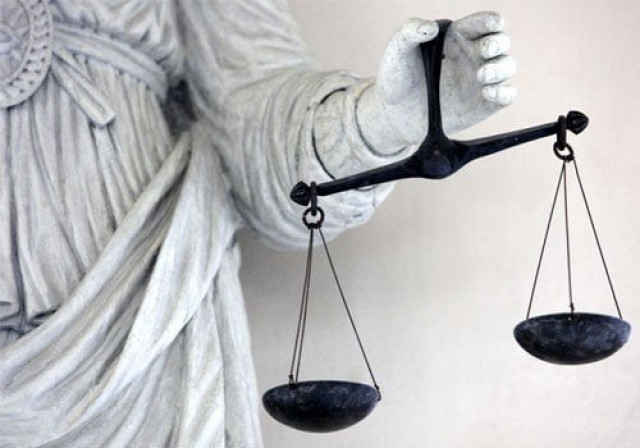Why are there so few women in the courts?
The court environment in Pakistan is almost completely male

Scale of justice. PHOTO: REUTERS
While men and women both suffer from challenges in their quest for rights in the overburdened justice system of Pakistan (the judges’ caseload may be as high as 2,000 cases per judge in the district judiciary in districts with large populations), women experience additional “barriers” in their ability to access justice mechanisms despite women’s rights and entitlements being enshrined in the Constitution and laws of Pakistan. The Global Gender Gap Report 2018 ranks Pakistan 148 out of 149 countries because our Economic Participation and Opportunity ranking is amongst the lowest in the world, manifests clearly in low participation, representation and ownership as well as control over resources by women. Economic constraints, social and psychological barriers and weaker access to information of the criminal justice system impacts women’s ability to access rights uniquely. The lack of money and assets puts women at a disadvantage where apart from travel and process-related costs, a person has to bribe officials to move the process along. Women also lack social capital required to move officials in Pakistan and face restrictions on their mobility determined by the cultural expectation that women will stay home and only travel with their families’ permission. But most importantly, there is a serious stigmatisation of women reporting sexual offences and of women claiming their rights in general. These factors are compounded by the fact that women are not raised to engage with public life, resulting in limited knowledge of public institutions and systems and non-existent social networks — both necessary to navigate the highly complex and opaque justice system of Pakistan.
It’s important to understand that a woman complaining against any denial of rights, especially sexual violence is challenged from the time of her birth to the time of her interaction with courts, due to multiple and intersecting factors. It begins with girls not being registered at birth; goes on to a lack of basic literacy — there is a gender gap of about 22% between men and women, leading to a lack of understanding of rights and processes; she often lacks a CNIC (current gap of 12 million between men and women); she will likely not be in formal employment (55% women work in informal work and only 2% are permanent workers); and she does not have money or assets (poverty has a woman’s face).
These dynamics set her up for failure before she gets to the justice sector but once there, she is met with a non-cooperative, insensitive and hostile police force that feels that only “bad” women get attacked and “good” women do not bring violence upon themselves because they do not leave their homes unaccompanied. She is also intimidated by the low numbers of women in the police (just over 1% in Pakistan with 98% at the constable level) who are not necessarily more sensitive towards women, but a victim (especially a young woman) will feel less shame in recounting the crime and will be less re-victimised when talking to another woman. The intimidation continues with an almost woman-free justice system with less than 12% women advocates and 16% women judges in the district judiciary. The court environment is almost completely male and if she wants information, she has to ask the teeming multitude of men around her, instead of being able to access a dedicated information window or desk.
When her case comes up for hearing, the court officials do not understand that the mere act of standing in an almost all-male and official court room is intimidating enough, let alone being confronted by her rapist or having to give evidence about intimate conduct before strangers, and the perpetual invocation of her moral character to indicate consent to sexual assault.
Improving access to rights for nearly 50% of Pakistan’s citizenry should begin with increased representation of women in the Police, on the bench and in the bar. Physical infrastructure of the justice sector institutions should be made more women friendly with improved public amenities, i.e., washrooms, waiting areas, women’s desks, etc. Legal aid mechanisms exist in Pakistan and are state-sanctioned but their performance is abysmal. Making legal aid cells and committees effective will play a crucial role in promoting gender equality. Increasing the number of courthouses and judges or creating mobile courts will benefit women, as they usually suffer from limited mobility and time and special courts and benches for women and gender units within the judiciary will improve conviction rates.
The Lahore Gender Based Violence Court (GBC) shows a four times higher conviction rate because of implementation of guidelines for sensitive trials, e.g., testifying in private chambers, and other measures for victims (non-adversarial procedures in resolving disputes, special waiting areas for victims, confidentiality and privacy, and simplified evidentiary requirements). The then chief justice of Pakistan, Honourable Justice Asif Saeed Khosa, had announced GBV courts in all districts across Pakistan. When established, they will be a game changer in improving women’s access to justice.
Finally, it is imperative we change the way justice sector service providers feel about and deal with women. That may be helped with increased and relevant gender sensitisation trainings at all levels across the justice delivery chain not only to increase their awareness on legislation and measures promoting women’s rights but also to help them understand the differential impact of their actions on women, who cannot be helped with the “justice is blind” approach.
Published in The Express Tribune, January 8th, 2020.
Like Opinion & Editorial on Facebook, follow @ETOpEd on Twitter to receive all updates on all our daily pieces.















COMMENTS
Comments are moderated and generally will be posted if they are on-topic and not abusive.
For more information, please see our Comments FAQ